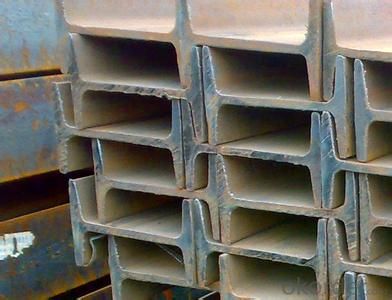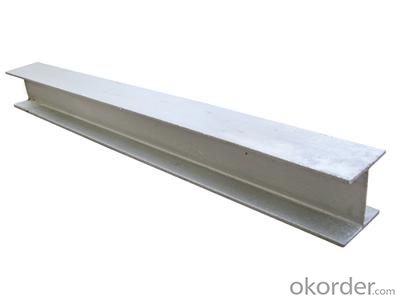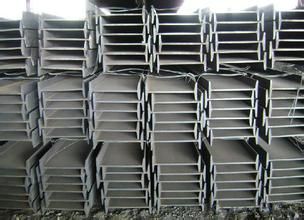High Quality BS Standard Structure Steel I Beam Details
- Loading Port:
- Tianjin
- Payment Terms:
- TT or LC
- Min Order Qty:
- 500 m.t.
- Supply Capability:
- 20000 m.t./month
OKorder Service Pledge
OKorder Financial Service
You Might Also Like
Product Description:
OKorder is offering High Quality BS Standard Structure Steel I Beam Detailsat great prices with worldwide shipping. Our supplier is a world-class manufacturer of steel, with our products utilized the world over. OKorder annually supplies products to European, North American and Asian markets. We provide quotations within 24 hours of receiving an inquiry and guarantee competitive prices.
Product Applications:
High Quality BS Standard Structure Steel I Beam Details are ideal for structural applications and are widely used in the construction of buildings and bridges, and the manufacturing, petrochemical, and transportation industries.
Product Advantages:
OKorder's High Quality BS Standard Structure Steel I Beam Details are durable, strong, and resist corrosion.
Main Product Features:
· Premium quality
· Prompt delivery & seaworthy packing (30 days after receiving deposit)
· Corrosion resistance
· Can be recycled and reused
· Mill test certification
· Professional Service
· Competitive pricing
Product Specifications:
Manufacture: Hot rolled
Grade: Q195 – 235
Certificates: ISO, SGS, BV, CIQ
Length: 6m – 12m, as per customer request
Packaging: Export packing, nude packing, bundled
Chinese Standard (H*W*T) | Weight (Kg/m) | 6m (pcs/ton) | Light I (H*W*T) | Weight (Kg/m) | 6m (pcs/ton) | Light II (H*W*T) | Weight (Kg/m) | 6M |
100*68*4.5 | 11.261 | 14.8 | 100*66*4.3 | 10.13 | 16.4 | 100*64*4 | 8.45 | 19.7 |
120*74*5.0 | 13.987 | 11.9 | 120*72*4.8 | 12.59 | 13.2 | 120*70*4.5 | 10.49 | 15.8 |
140*80*5.5 | 16.89 | 9.8 | 140*78*5.3 | 15.2 | 10.9 | 140*76*5 | 12.67 | 13.1 |
160*88*6 | 20.513 | 8.1 | 160*86*5.8 | 18.46 | 9 | 160*84*5.5 | 15.38 | 10.8 |
180*94*6.5 | 24.143 | 6.9 | 180*92*6.3 | 21.73 | 7.6 | 180*90*6 | 18.11 | 9.2 |
200*100*7 | 27.929 | 5.9 | 200*98*6.8 | 25.14 | 6.6 | 200*96*6.5 | 20.95 | 7.9 |
220*110*7.5 | 33.07 | 5 | 220*108*7.3 | 29.76 | 5.6 | 220*106*7 | 24.8 | 6.7 |
250*116*8 | 38.105 | 4.3 | 250*114*7.8 | 34.29 | 4.8 | 250*112*7.5 | 28.58 | 5.8 |
280*122*8.5 | 43.492 | 3.8 | 280*120*8.2 | 39.14 | 4.2 | 280*120*8 | 36.97 | 4.5 |
300*126*9 | 48.084 | 3.4 | 300*124*9.2 | 43.28 | 3.8 | 300*124*8.5 | 40.87 | 4 |
320*130*9.5 | 52.717 | 3.1 | 320*127*9.2 | 48.5 | 3.4 | |||
360*136*10 | 60.037 | 2.7 | 360*132*9.5 | 55.23 | 3 |
FAQ:
Q1: Why buy Materials & Equipment from OKorder.com?
A1: All products offered byOKorder.com are carefully selected from China's most reliable manufacturing enterprises. Through its ISO certifications, OKorder.com adheres to the highest standards and a commitment to supply chain safety and customer satisfaction.
Q2: How do we guarantee the quality of our products?
A2: We have established an advanced quality management system which conducts strict quality tests at every step, from raw materials to the final product. At the same time, we provide extensive follow-up service assurances as required.
Q3: How soon can we receive the product after purchase?
A3: Within three days of placing an order, we will begin production. The specific shipping date is dependent upon international and government factors, but is typically 7 to 10 workdays.
Q4: What makes stainless steel stainless?
A4: Stainless steel must contain at least 10.5 % chromium. It is this element that reacts with the oxygen in the air to form a complex chrome-oxide surface layer that is invisible but strong enough to prevent further oxygen from "staining" (rusting) the surface. Higher levels of chromium and the addition of other alloying elements such as nickel and molybdenum enhance this surface layer and improve the corrosion resistance of the stainless material.
Q5: Can stainless steel rust?
A5: Stainless does not "rust" as you think of regular steel rusting with a red oxide on the surface that flakes off. If you see red rust it is probably due to some iron particles that have contaminated the surface of the stainless steel and it is these iron particles that are rusting. Look at the source of the rusting and see if you can remove it from the surface.
Images:


- Q: Can steel I-beams be used in retail or shopping center construction?
- Yes, steel I-beams can be used in retail or shopping center construction. They are commonly used in commercial construction due to their strength, durability, and ability to support heavy loads. Steel I-beams provide structural stability, allowing for large open spaces and flexible floor layouts, which are often desired in retail or shopping center designs.
- Q: How do steel I-beams perform in extreme weather conditions?
- Steel I-beams are known for their exceptional strength and durability, making them highly suitable for withstanding extreme weather conditions. Whether it is extreme heat, freezing temperatures, heavy rainfall, or strong winds, steel I-beams can perform exceptionally well. One of the key advantages of steel I-beams is their resistance to temperature fluctuations. Unlike other materials, steel does not expand or contract significantly due to temperature changes. This makes steel I-beams particularly reliable in extreme heat or cold, ensuring that they maintain their structural integrity over time. In severe weather conditions such as hurricanes or strong winds, steel I-beams are highly resistant to bending or breaking. The I-shape design of the beams provides excellent load-bearing capabilities, allowing them to withstand heavy winds and prevent structural failures. This is particularly important in areas prone to tornadoes, hurricanes, or other high-wind events. Steel I-beams also perform well in heavy rainfall or snowfall. Their inherent strength allows them to bear the weight of accumulated snow or the force of heavy rain without buckling or collapsing. Additionally, steel is resistant to water damage, corrosion, and rotting, ensuring the longevity and structural stability of the I-beams in wet conditions. Moreover, steel I-beams have a high fire resistance compared to other materials. In the event of a fire, steel does not combust, melt, or contribute to the spread of flames. This characteristic makes steel I-beams a reliable choice in areas prone to wildfires or other fire hazards. Overall, steel I-beams are designed to withstand extreme weather conditions and perform exceptionally well in such situations. Their strength, durability, resistance to temperature fluctuations, wind resistance, and fire resistance make them a reliable choice for various construction projects, ensuring the safety and stability of structures even in the harshest weather conditions.
- Q: Can steel I-beams be used in water treatment plant construction?
- Yes, steel I-beams can be used in water treatment plant construction. Steel is a highly durable and strong material that is often used in construction projects, including water treatment plants. Steel I-beams are commonly used for structural support in buildings and infrastructure due to their strength and load-bearing capabilities. In water treatment plants, where there may be heavy equipment and structures that require support, steel I-beams are frequently utilized to ensure the stability and integrity of the overall construction. Additionally, steel is resistant to corrosion, which is particularly important in water treatment plants where the presence of water and chemicals can cause damage to other materials over time. Therefore, steel I-beams are a suitable choice for constructing water treatment plants, providing the necessary strength, durability, and resistance to corrosion.
- Q: How long do Steel I-Beams last?
- Steel I-beams can last for several decades, typically ranging from 50 to 100 years, depending on various factors such as the quality of the steel, the environment they are exposed to, and the level of maintenance they receive.
- Q: Can steel I-beams be used for industrial warehouses?
- Yes, steel I-beams are commonly used for industrial warehouses due to their high strength and load-bearing capacity. They provide structural support and can withstand heavy loads, making them ideal for large-scale industrial buildings.
- Q: How do steel I-beams perform in terms of stiffness and rigidity?
- Steel I-beams are highly regarded for their exceptional stiffness and rigidity, making them the perfect choice for structural purposes. The distinctive construction of I-beams, featuring a vertical web that connects the top and bottom flanges, enables them to effectively distribute loads and withstand bending and deflection. In terms of stiffness, steel I-beams offer impressive resistance to deformation when subjected to applied loads. The vertical web acts as a solid support, preventing excessive sagging or bending of the beam. This stiffness guarantees that the beam maintains its shape and structural integrity, even under demanding loads or harsh environmental conditions. Rigidity, which refers to a material's ability to resist deformation or bending, is a key trait of steel I-beams. Their composition, including a combination of iron and carbon, endows them with high rigidity. This combination results in a strong and rigid material that can endure substantial forces without experiencing excessive deflection or deformation. Moreover, the shape of I-beams also contributes to their excellent stiffness and rigidity. The flanges situated at the top and bottom of the beam provide additional strength and resistance against bending moments. This design allows the I-beam to efficiently distribute loads and minimize deflection, thus making it suitable for applications that demand stable and rigid structures. In conclusion, steel I-beams are widely recognized for their remarkable stiffness and rigidity. Their unique shape and composition make them highly resistant to bending and deformation, enabling them to provide reliable support and structural integrity in various applications, including building construction, bridges, and industrial structures.
- Q: How are steel I-beams protected from corrosion?
- There are several methods available to protect steel I-beams from corrosion. Among them, one commonly used approach is to apply a protective coating. This coating can take the form of paint, epoxy, or a zinc-based material. Its purpose is to act as a barrier, preventing moisture and oxygen from reaching the metal surface and causing corrosion. Additionally, steel I-beams can also undergo galvanization. This process entails applying a layer of zinc to the beams, either through hot-dip galvanizing or electroplating. The zinc coating serves as sacrificial protection, corroding in place of the steel and effectively safeguarding the I-beams against rust. Another method for corrosion protection is cathodic protection. This technique involves connecting the steel I-beams to a sacrificial anode, such as zinc or aluminum, using a conductive material. By doing so, the anode corrodes instead of the steel, thus preserving the integrity of the I-beams. To ensure the continued effectiveness of these protective measures, regular maintenance and inspection are essential.
- Q: How do steel I-beams contribute to the overall stability of a building?
- Steel I-beams contribute to the overall stability of a building in several ways. First and foremost, I-beams are renowned for their exceptional strength and load-bearing capacity. Due to their unique shape, I-beams are able to distribute the weight of the building evenly and efficiently, minimizing the risk of structural failure. The vertical web of the I-beam provides maximum resistance against bending and buckling, allowing it to support heavy loads and resist external forces such as wind or seismic activity. Moreover, the use of steel I-beams in construction allows for longer spans and greater open spaces within a building. This is because I-beams can support larger loads without the need for additional columns or supports. The ability to have larger uninterrupted floor areas enhances the flexibility and functionality of the building, allowing for various design possibilities and accommodating different uses. Steel I-beams also contribute to the overall stability of a building by providing structural rigidity. The inherent stiffness of steel, combined with the efficient design of the I-beam, helps to minimize deflection and sway in the building during dynamic events such as strong winds or earthquakes. This ensures that the building remains stable and can withstand external forces without compromising its structural integrity. Furthermore, steel I-beams are highly durable and resistant to corrosion, which is particularly important in areas with high humidity or exposure to harsh weather conditions. This durability ensures that the building's structural elements remain intact over time, reducing the risk of deterioration and ensuring long-term stability. In summary, steel I-beams contribute to the overall stability of a building through their exceptional strength, load-bearing capacity, and resistance to bending and buckling. They provide structural rigidity, allow for larger open spaces, and offer durability against corrosion. By incorporating steel I-beams into the construction process, buildings can achieve enhanced stability, safety, and longevity.
- Q: Can steel I-beams be used in educational or institutional building construction?
- Certainly, steel I-beams can be used in the construction of educational or institutional buildings. The construction industry widely utilizes steel I-beams due to their strength, durability, and versatility. They offer exceptional structural support and have the ability to withstand heavy loads, making them ideal for large-scale buildings like schools and universities. When it comes to educational or institutional building construction, steel I-beams provide numerous advantages. Firstly, their strength-to-weight ratio is impressive, meaning they can support heavy loads while keeping the overall weight of the structure to a minimum. This results in more efficient and cost-effective construction, as it reduces the need for excessive materials and foundation support. Moreover, steel I-beams can be easily fabricated and customized to meet specific design requirements. They come in various sizes and shapes, allowing for flexible design possibilities. This is especially advantageous in educational or institutional buildings, as it eliminates the need for excessive supporting columns and enables the creation of large open spaces, such as auditoriums or gymnasiums. Additionally, steel I-beams possess resistance to fire, rot, and pests, ensuring the building's longevity and safety. They also have a long lifespan, requiring minimal maintenance over time. This makes them a reliable choice for educational or institutional buildings that are expected to have a lengthy operational life. In conclusion, steel I-beams are highly suitable for educational or institutional building construction due to their strength, durability, versatility, and cost-effectiveness. They offer the necessary structural support, allow for flexible design possibilities, and guarantee the safety and longevity of the building.
- Q: Can steel I-beams be used in transportation or infrastructure renovation projects?
- Indeed, steel I-beams find great application in transportation and infrastructure renovation projects. Owing to their robustness and resilience, steel I-beams are frequently employed in construction. They prove particularly valuable in the construction of bridges, highways, and various other transportation infrastructure projects, where a sturdy and dependable support structure is imperative. Additionally, steel I-beams can effectively contribute to the refurbishment of preexisting infrastructure by reinforcing or substituting deteriorating bridges or overpasses. Their adaptability and capacity to bear heavy loads render them an optimal choice for transportation and infrastructure projects.
Send your message to us
High Quality BS Standard Structure Steel I Beam Details
- Loading Port:
- Tianjin
- Payment Terms:
- TT or LC
- Min Order Qty:
- 500 m.t.
- Supply Capability:
- 20000 m.t./month
OKorder Service Pledge
OKorder Financial Service
Similar products
Hot products
Hot Searches
Related keywords





























